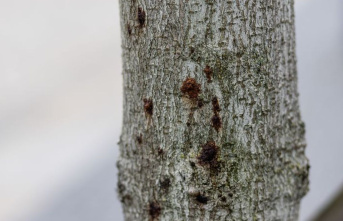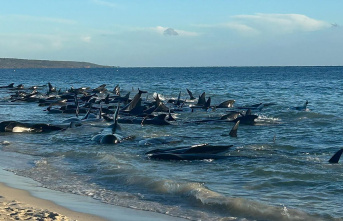After outbreaks of the deadly Marburg fever in two African countries, the World Health Organization (WHO) wants to contain the pathogen quickly - promising vaccines are also to be used. Cases of the disease have appeared for the first time both in Equatorial Guinea, a small country with 1.5 million inhabitants on Africa's west coast, and in East African Tanzania with around 63 million inhabitants.
The Marburg virus, which is related to the Ebola pathogen, triggers symptoms such as fever, cramps, bloody vomiting and diarrhea. Depending on the treatment options, up to 88 percent of those affected die.
No vaccines or therapeutics have yet been approved, but there are vaccine candidates and drugs that could help fight the outbreak, said WHO Director Tedros Adhanom Ghebreyesus in Geneva. After the outbreak in Tanzania, experts are ready to test promising vaccines there. "The developers are on board, the clinical trial protocols are ready, the experts and donors are ready as soon as the national government and researchers give the green light," said Tedros. The WHO had also offered this in Equatorial Guinea.
WHO wants to break the chain of transmission quickly
In Equatorial Guinea, cases detected up to 150 kilometers apart indicated a wider spread of the virus, the WHO said. Of nine laboratory-confirmed patients since February, seven died. 20 other dead were also likely infected. Due to the proximity to the neighboring countries Cameroon and Gabon, the WHO sees a medium risk for the region and a high risk for the country itself, whose inhabitants are among the poorest people in the world according to the UN.
The chain of transmission must be broken quickly to "prevent a possible large-scale outbreak and loss of life," said WHO Regional Director for Africa Matshidiso Moeti. "Marburg is highly virulent but can be effectively controlled and stopped with the immediate deployment of a wide range of measures to combat the outbreak."
The outbreak in Tanzania became known on Tuesday. According to the Ministry of Health, eight infections were detected there and five people died. The outbreak is under control and has been limited to the Kagera region in the northwest of the country, it said. Tanzania's government announced travel restrictions and contact tracing measures for the affected region on Thursday. According to the WHO, the incubation period is between two and 21 days.
Marburg fever is transmitted from animals to humans
The WHO has put the virus family that causes Marburg fever and the equally deadly Ebola disease on a priority list for more research and to prepare for major outbreaks. The list is about bacteria and viruses that could cause outbreaks, spread and become a pandemic, said Ana Mario Restrepo of the WHO Health Emergencies Programme.
Marburg fever is a so-called zoonosis, it is initially transmitted from animals to humans. The disease is highly contagious among humans through contact with bodily fluids. Patients initially have a high fever, sore throat, muscle pain, abdominal pain and headache, as well as diarrhea. In severe cases, there is also heavy bleeding and an attack on the central nervous system. The virus is called Marburg because laboratory employees in the Hessian city became infected with the previously unknown virus in test monkeys in 1967.
Even without vaccines and medication, a lot can be done to prevent the spread of Marburg fever, Tedros said: "Careful identification of contact persons, their isolation and care (of the sick) are effective tools to prevent the transmission of Marburg and to save lives rescue."
Most recently, three people died in Ghana in West Africa last year. According to the WHO, there had previously been outbreaks of Marburg fever in Guinea (2021), Uganda (2017, 2014, 2012, 2007), Angola (2004-2005), the Democratic Republic of the Congo (1998 and 2000), Kenya (1990, 1987, 1980) and South Africa (1975).











